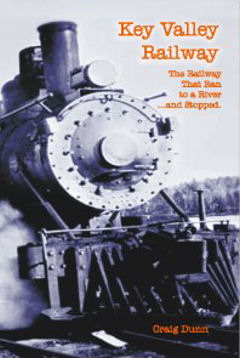

Key Valley Railway
-The Railway That Ran to a River
…and Stopped.
by Craig Dunn
The Key Valley Railway was located in the Muskoka region, a major area for logging in the province of Ontario from about 1919 until 1935. Sixteen miles long, the railway connected to the CPR main line at Pakesley, ran on the north side of the Key River to Lost Channel on the Pickerel River, and stopped.
It's primary function was to move the enormous amounts of lumber being logged in that area to market. The busy season for passenger travel was the autumn of each year as over 1,500 hunters moved into camps on the Pickerel River.
The mill at Lost Channel was well ahead of its time. The town had running water and electricity. The mill had a steam-powered electric generator that supplied power throughout the town. The concrete structure that housed the water pump and electrical generator is the only building that remains of the original town of Lost Channel.
The Key Valley Railway was built through land known as hardscrabble. Hardscrabble is a thin layer of earth covering igneous rock. This may account for the owners of the mill at Lost Channel growing close to bankruptcy before selling to another owner who was able to finish the railroad. It has to be assumed that the builders didn't waste money blasting a great deal of rock to make the line straight or the clearances wide; they simply built around a lot of the obstacles. This made for numerous curves in the track.
The busy season for passenger travel was the autumn of each year as over 1,500 hunters moved into camps on the Pickerel River. The KVR appears to have had servicing facilities at each end of the sixteen mile line. It is a fact that the KVR shops were located beside the mill at Lost Channel but as this structure burnt down it is difficult to determine what it contained or what it looked like.

Large yards were a requirement at the interchange end of the line. At Pakesley, the KVR had laid over six miles of track solely for the purpose of storing cut lumber and allowing it to dry. The yards were expanded a number of times during the life span of the KVR.
The mill at Lost Channel was well ahead of its time. The town had running water. As well, electricity was part of the life in Lost Channel. The mill had a steam-powered electric generator that supplied power throughout the town. The concrete structure that housed the water pump and electrical generator is the only building that remains of the original town of Lost Channel.
The amount of lumber shipped was enormous. The Mill at Lost Channel could cut 85,000 board feet of white pine in a shift, and on one occasion cut 140,000 board feet of red pine. (A board foot is 12" x 12" x 1") [30.48 cm x 30.48 cm x 2.54cm] To accommodate the large amount of lumber, Key Valley built a yard at Pakesley with supposedly over six miles of track. The yard was usually full as an excess of 40 million board feet of lumber were stored here. From September to December during the busiest years, the Key Valley Railway shipped 150,000 board feet of lumber per day during the autumn of the year from the Pakesley yard.
The Key Valley Railway, being privately owned, did not come under the same laws established by the Canadian Transportation Board as other railroad companies did concerning the carrying of passengers. The Key Valley posted a notice that bluntly stated, "passengers traveled completely at their own risk" and that "the railway would not be responsible for any injuries or deaths."
With the depression controlling the economy of the 1930s, the mill was unable to sell the lumber that was already cut and was forced to close. Over a million board feet of lumber was sold for a small fraction of their original value. The locomotives moved on to other places. The flat cars owned by the KVR went to scrap and all structures of any value were dismantled, as was the case with the mill. The 70 lb rails were lifted in 1935 and sold. With that, the KVR ceased to exist and is now only a memory for a few in an under-populated part of the province.
A number of drawings have been included with the material on the Key Valley Railway for any reader that would like to attempt to model the KVR.
ISBN: 9781894747332 | WMPub#1014 | 6" x 9"
64 page trade paperback | 36 photos, 10 diagrams | $15.95 CDN
Available In EBook Formats Here: $7.50 | EPub format |
Kindle Format |
Some additional material is included in the ebook that was not available at the time of printing the original.  |
